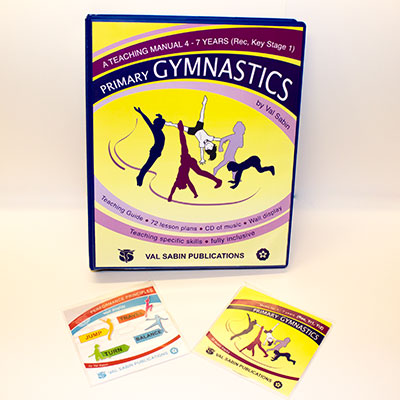Val Sabin Primary School Gymnastics Reception and Key Stage 1 (4-7 Years):

DIGITAL VERSION OF THIS CORE CURRICULUM KEYSTAGE MANUAL NOW AVAILABLE IN PDF FORMAT WITH MUSIC IN MP3 FORMAT. CONTACT US FOR MORE INFO.
- User-friendly scheme for the whole school.
- A comprehensive scheme of work for Primary School Gymnastics Reception and Key Stage 1 (4-7 Years).
- A teaching guide including planning and assessment sheets.
- A comprehensive section on lifting, carrying, construction and use of apparatus.
- 72 lesson plans in 12 units of work.
- CD of music for warm-ups and sequences.
- CD containing wall display to aid independent learning.
- Progressive and developmental material.
- Detailed section on teaching specific fundamental skills.
- Photocopiable (in the purchaser’s school only).
- Exceeds National Curriculum requirements.
Gymnastics Reception & Key Stage 1 Sample Pages
View Gymnastics Rec/KS1 Sample Pages
Gymnastics Training
Read about Gymnastics Training
Gymnastics Videos
View our Gymnastics lesson videos on YouTube
Introduction to Gymnastics Reception and Key Stage 1 (4-7 Years)
It gives school teachers practical and definite guidance on material, lesson structure and the handling, construction and use of apparatus. It enables teachers to achieve a high quality of delivery and provide satisfying and progressive work for the children. This manual also exceeds National Curriculum 2014 expectations.
Whilst working as an advisor I became aware of such needs as:- appropriate selection of themes; composition and suitable presentation of lessons; delivery of material in a progressive way; teaching basic specific skills safely; handling construction and use of apparatus; the need for a simple assessment scheme.
Teaching Material
This Primary School Gymnastics manual is designed to answer these problems in a thoroughly practical way. It provides a complete tool kit of 72 ready-made lesson plans with all the material you need. These include a detailed section:
- Teaching specific skills.
- Cards for ideas, skill teaching, check lists and core tasks.
- CD containing a wall display to help with independent learning and assessment.
- CD containing 32 tracks of music. The CD includes music for warm-ups and a short sequence at the end of each unit of work. It has been constructed to develop and progress children logically through a unit of work, through a year, from one year to the next and one key stage to the next.
The temptation with a manual such as this is to turn immediately to the lesson units and select one for use! However, whatever the temptation, may I suggest that you initially read the introductory sections because they contain very important information on:
- Lesson structure.
- Presentation.
- Teaching gymnastics skills.
- Apparatus handling.
….which will help you deliver the lesson units in a more satisfying and enjoyable way, both for the children and yourself.
Lesson Plans
Every lesson plan contains enough material for the delivery of at least two lessons, and if occasionally you wish to select one lesson or a part unit, and develop it into a half-term unit, the sections at the front will explain the best way of doing it.
Additional Needs
There is no additional (special) needs section in this Primary School Gymnastics teaching manual. Tasks and activities have been designed to allow for achievement and success within a wide range of abilities. The author has found that slight adaptation of any of the tasks or going back a stage(s) in the teaching of skills would include most children with partial physical impairment or disability.
Both the detailed, logical, build up of skills and the challenging extension cards in the “specific skills” section of the manual will prove very effective in developing the skills of children ranging from those who have co-ordination and mobility problems through to the gifted and talented.
This manual was originally produced and published to answer a specific need and is often updated. All the material is thoroughly tested and proven and is now used in schools all over the world with excellent results. I am sure you will find it a very practical aid in the construction and delivery of a progressive scheme of work for gymnastics in your school ranging from those who have co-ordination and mobility problems through to the gifted and talented.
How can it help you teach Primary School Gymnastics
The manuals are designed to improve your teaching performance mainly through the delivery of proven, high quality lesson material. The whole programme will physically develop the children in a logical and progressive manner giving more satisfaction and enjoyment.
How to teach gymnastics skills and the principles of teaching gymnastics are precisely detailed along with lesson structure, programmes of study and techniques for making the most of available apparatus. The manuals contain a guide for teaching gymnastics and a complete programme of 12 units of work containing 72 lesson plans for reception and Key Stage 1 (4-7 yrs).
Save time on Lesson Planning
The manuals include a complete tool kit of ready made lesson plans with all the material you need to deliver the National Curriculum 2014 requirements for gymnastics. Each unit of lessons follows a theme and is so constructed to enable children to develop and progress through at least half a term of gymnastics extending their knowledge, skills and understanding and creating sequences.
Complete and detailed programmes of study are included for each year group and there are also suggestions for cross-curricular links.
There is a substantial section at the end of each manual on how to teach specific gymnastic skills. A detailed build up of each skill is accompanied by teaching points, common faults, and suggested remedies along with a wealth of creative suggestions for moving into and from different skills. There are also extension cards to aid differentiation in the class situation.
The lessons within the manual can be used by teachers with differing levels of confidence and skill. The less confident can even read out tasks to the children, word for word, knowing that a well constructed and progressive set of lessons Is being delivered. Experienced and confident teachers can use the lesson structures as sound bases for further innovation and development.
How can you use the scheme?
Long Term Planning
In the Teaching Guide the unit titles are set out in a grid to enable easy identification of Long Term Planning. There is more than enough material available for each year group and this enables schools and teachers to exercise choice when planning. The co-ordinator (in discussion with staff) identifies which of the four units of work will be used in each year group and places them in the relevant time slots.
Medium Term Planning
At the beginning of each unit of work, the medium term plan is detailed. It contains learning objectives, unit framework and expected learning outcomes together with references to the skill development section at the back of the manual. For Foundation Stage the Medium Term Plan follows the same format, but in addition, references are detailed for linking up “Action Kids Physical Development with Fun” activities.
Short Term Planning
The detailed lesson plans form the short-term planning. The detailed content allows teachers to use them in a way which is compatible with their levels of confidence and skill.
Price
£75.00 (Hardback)
Please contact us to place your order.

